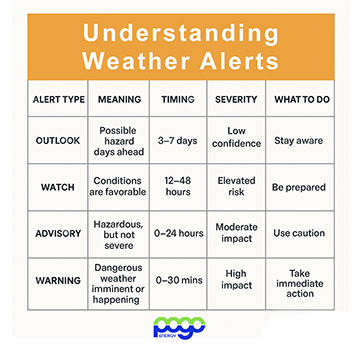Here in Texas, the weather can go from sunny skies to severe storms in a matter of minutes. Knowing when to flee, or when to shelter in place and ride out a storm, is imperative and can mean the difference between life and death. Texas experiences a wide range of weather conditions, including hurricanes, tornadoes, thunderstorms with flash flooding, and occasional snowstorms. As a result, Texans must educate themselves on the various warnings, watches, and alerts issued by the National Weather Service.
Understand Weather Alerts
That’s why it’s so important to understand the alerts issued by the National Weather Service (NWS). At Pogo Energy, we believe that knowledge is power, so we want to provide you with the information that empowers you to be prepared. What exactly is the difference between a weather warning, watch, advisory, and outlook? Let’s break down weather alerts and what each means.
Weather Warning- Take Protective Action Now
A warning means severe weather is currently occurring or is about to happen soon in your area. It’s the most urgent type of alert.
What it means: Dangerous weather like a tornado, flash flood, or severe thunderstorm has been spotted or detected by radar.
What to do: Seek shelter immediately. Follow local emergency instructions. Charge your phone and flashlights in case the power goes out.
Example Weather Alert Warning: A Tornado Warning means a tornado is either spotted or indicated by radar, not just possible, but imminent. If a warning is issued, unplug electronics if it’s safe to do so. Lightning strikes and power surges can damage your devices.
Weather Watch- Be Prepared With a Plan
A watch means conditions are favorable for severe weather, but it hasn’t happened yet. It’s a heads-up to stay alert and be prepared to act.
What it means: The atmosphere is primed for things like large hail, damaging winds, or flash flooding, but nothing’s happening just yet.
What to do: Review your emergency plan. Keep an eye on local news or weather apps for updates. Stay weather-aware.
Example Weather Alert Watch: A Severe Thunderstorm Watch indicates that storms could develop with strong winds and hail, but they aren’t currently occurring.
Weather Advisory- Be Aware & Use Caution
An advisory is issued when weather conditions could cause inconvenience or minor safety concerns, but are not life-threatening if precautions are taken.
What it means: Weather might not be extreme, but it could still impact your day, like icy roads or strong winds.
What to do: Use caution. Slow down when driving. Check on neighbors, especially those who are vulnerable or without air conditioning.
Example Weather Alert Advisory: A Heat Advisory means it’s going to be dangerously hot, and staying hydrated is a must.
During heat advisories, your A/C is working overtime. Set your thermostat a few degrees higher and use fans to keep cool while managing your energy costs.
Weather Outlook- Prepare a Plan
A weather outlook is issued early in the forecast period, when confidence is still low but possible. It’s intended to raise awareness and support long-term planning.
What it means: A hazardous weather event is possible in the future, typically 3 to 7 days out.
What to do: Stay informed and monitor future forecasts. It’s too early for action, but good to be weather-aware.
Example Outlook: A Winter Storm Outlook might be issued on a Monday if there is a probable possibility that a storm could hit on Friday.

Stay Connected With Pogo Energy
Whether it’s a watch, warning, or advisory, being prepared can make all the difference. Severe weather can affect your electricity, but with Pogo Energy’s prepaid plans, there are no surprises; you’re in complete control of your energy use and budget. And remember, Pogo Energy is here to power you through any storm.
